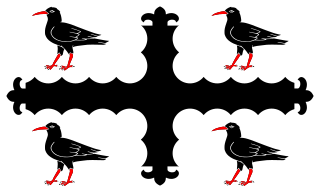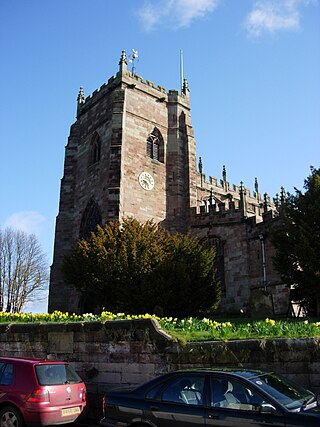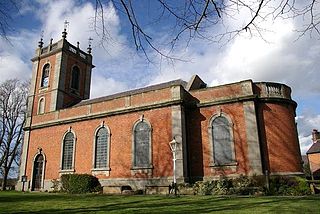Etymology, history
Threapwood developed on an area of common land, historically a tract of woodland lying between Cheshire and Flintshire, which was traditionally reputed to have fallen outside of county, parish and township boundaries: it was therefore outside the jurisdiction of any Justice of the Peace and paid no land tax or parish rates. This status was reflected in its name, with threap being a common Old English place name element referring to disputed boundary areas. [1]
This vague administrative status was to lead to Threapwood gaining a reputation as a home to "abandoned characters of every description, and especially of women of loose or blemished morals". [2] It was also a refuge for military deserters. [3] Various attempts were made to bring Threapwood within the normal administrative structure; by the Militia Acts of 1792 it was decreed to be in Worthenbury – though for the purposes of the militia only – and the Mutiny Act 1797 placed it in the parish of Malpas. [4]
Until Victorian times the village continued to be regarded as partly in Cheshire, and partly in Flintshire. But in 1896, under the "County of Chester (Threapwood) Order", the county boundary (and therefore the boundary between England and Wales), which passed through the village, was adjusted slightly in favour of Cheshire.

Flintshire is a county in the north-east of Wales. It has a maritime border with Merseyside along the Dee Estuary to the north, and land borders with Cheshire to the east, Wrexham County Borough to the south, and Denbighshire to the west. Connah's Quay is the largest town, while Flintshire County Council is based in Mold.

Flintshire, also known as the County of Flint, is one of Wales' thirteen historic counties, and a former administrative county. It mostly lies on the north-east coast of Wales.

Chester was a non-metropolitan local government district of Cheshire, England from 1974 to 2009. It had the status of a city and a borough, and the local authority was called Chester City Council.
The Maelor is an area of north-east Wales along the border with England. It is now entirely part of Wrexham County Borough.

English Maelor comprises one half of the Maelor region on the Welsh side of the Wales-England border, being the area of the Maelor east of the River Dee. The region has changed counties several times, previously being part of Cheshire and later a detached portion of Flintshire. The area is currently in Wales, despite its name, and administered as part of Wrexham County Borough.

Saltney is a town straddling the counties of Flintshire and Cheshire on the England–Wales border. The community of Saltney lies entirely in Wales. The town forms part of Chester's built-up area and is around 5 miles from Deeside.

Overton or Overton-on-Dee is a village and community in Wrexham County Borough, Wales. It is situated close to the Welsh-English border on the edge of an escarpment that winds its way around the course of the River Dee, from which Overton-on-Dee derives its name.

No Man's Heath is a village in the unitary authority of Cheshire West and Chester and the ceremonial county of Cheshire, England. Its name has historically also been spelt Nomansheath and Noman's Heath, the latter being the version formerly favoured by the General Post Office.

Cuddington Heath is a village and a civil parish in the unitary authority of Cheshire West and Chester and the ceremonial county of Cheshire, England. The village is close to the border with Wales, and the nearest large town is Wrexham in Wales, about ten miles west. Other nearby villages are Threapwood, Malpas and Chorlton Lane. At the 2001 Census, the parish had a population of 180, falling slightly to 171 at the 2011 Census.

Tushingham cum Grindley is a former civil parish, now in the parish of Tushingham-cum-Grindley, Macefen and Bradley, in the unitary authority of Cheshire West and Chester and the ceremonial county of Cheshire, England. The parish contained the village of Tushingham and the hamlet of Bell o' th' Hill. According to the 2001 UK census, the total population of the civil parish was 166, rising to 187 at the 2011 Census. The civil parish was abolished in 2015 to form Tushingham-cum-Grindley, Macefen and Bradley.

Malpas is a market town and a civil parish in the unitary authority of Cheshire West and Chester and the ceremonial county of Cheshire, England. It lies near the borders with Shropshire and Wales, and had a population of 1,673 at the 2011 census.

Tarvin was, from 1894 to 1974, a rural district in the administrative county of Cheshire, England. The district was named after the village of Tarvin, and saw considerable boundary changes throughout its life.

Higher Kinnerton is a village and community within rural Flintshire, Wales, close to the Wales-England border. Its sister village, Lower Kinnerton, is across the border in Cheshire, England.
The Hundreds of Cheshire, as with other Hundreds in England, were the geographic divisions of Cheshire for administrative, military and judicial purposes. They were introduced in Cheshire some time before the Norman conquest. Later on, both the number and names of the hundreds changed by processes of land being lost from Cheshire, and merging or amalgamation of remaining hundreds. The Ancient parishes of Cheshire were usually wholly within a specific hundred, although a few were divided between two hundreds.

Shocklach Oviatt is a former civil parish, now in the parish of Shocklach Oviatt and District, in the unitary authority of Cheshire West and Chester and the ceremonial county of Cheshire, England. The parish of Shocklach comprised the townships Shocklach Oviatt, Church Shocklach and Caldecott. The civil parish was abolished in 2015 to form Shocklach Oviatt and District.

St John's Church is in the village of Threapwood, Cheshire, England. It is an active Anglican parish church in the diocese of Chester, the archdeaconry of Chester, and the deanery of Malpas. Its benefice is combined with those of St Oswald, Malpas and Holy Trinity, Bickerton. The church is recorded in the National Heritage List for England as a designated Grade II* listed building. The authors of the Buildings of England series state that it is entirely Georgian in style.

Willington Worthenbury is a community in Wrexham County Borough, Wales, and is situated near the England–Wales border.

Oldcastle is a former civil parish, now in the parishes of Malpas and Threapwood, in the Cheshire West and Chester district and ceremonial county of Cheshire in England. In 2001 it had a population of 54. The civil parish was abolished in 2015 and merged into Malpas and Threapwood.

The Wych Brook, Worthenbury Brook and Red Brook, formerly known as the River Elfe, is a tributary of the River Dee in England and Wales, forming part of both the historic and present-day border between the two countries. The stream forms part of the border between Cheshire and Shropshire in England to the east, and Wales, particularly the Maelor Saesneg, to the west.

Whitewell is a dispersed rural settlement, and surrounding ecclesiastical parish, in the community of Bronington, in the east of Wrexham County Borough, Wales.




















